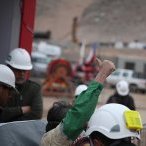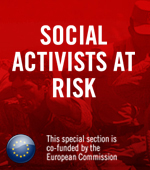
13 October 2010 | News | Extractive industries
Cheers!
Chile after the feats of the miners: lessons of an industry that kills
Download: MP3 (3 Mb)
Twenty out of the 33 miners who were trapped 69 days ago 700 meters deep in San Jose mine in Chile have been rescued at the time of writing this article. The rescue team will not rest until the other 13 miners come to the surface. Chile is celebrating. This new accident of the mining sector could´ve had a tragic outcome, as many have.
On Wednesday, at 12:10 am, Chilean time, Florencio Avalos (31) was pulled to the surface by the Fenix capsule, specially designed for this rescue, in charge of state mining company Codelco. Avalos was the first worker to be rescued and he was greeted by his family, friends from the sector, Chilean President, Sebastian Piñera, and Mining Minister, Laurence Golborne, among other authorities.
In general terms, all workers rescued so far are in good health. The last miner to reach the surface, probably by Wednesday´s evening, will be the worker in charge of the group at the time of the accident on August 5th, Luis Urzúa (54), considered the leader of the group.
The San Jose copper and gold mine, owned by San Esteban company, is located in Copiapo city, in Atacama Desert, 800 kilometers north from the capital city of the country, Santiago. The company had been already denounced due to the poor safety conditions of the workers, including in that mine.
For instance, in 2007, workers of the company together with unions of other companies filed a complaint to the Appeals Court and the National Geology and Mining Service for the death of three workers in San Jose and San Antonio mine. The workers demanded the closure of San Jose, and the union of the company said that there were no proper ways of escape or the necessary ventilation in the mine, and that the authorities knew this situation.
Chilean newspaper La Nacion reported on September 22nd that “in 2007, the mine was closed after the death of a worker, and restarted its operations in 2008 without taking the necessary measures”. “Everybody knew that this old copper and gold mine was not safe. Approximately 80 accidents were denounced throughout the decades”, stated La Nacion.
The businessmen owners of San Esteban, Alejandro Bohn and Marcelo Kemen, chose to leave the mine on August 22nd, only two days after it was reported that the workers were alive. They haven´t been to the “Esperanza” campsite, where the families of the miners have been waiting for the rescue for over two months.
There are several legal complaints filed against San Esteban due to the collapse of San Jose mine and previous accidents. The families of around 30 of the miners are demanding the company the payment of compensation worth 12 million dollars. It is expected that the company will declare bankruptcy. The Chilean State will face another request for compensation due to failure in monitoring the mine.
The story of the 33 miners trapped in Chile has so far a happy ending. Congratulations! Sadly, the stories with happy endings are not many in the sector. In Chile, according to statistics by the National Geology and Mining Service, 373 workers died in mining accidents in the last decade. In 2010, 31 people died.
At world level, the deaths amount to thousands per year. According to the International Federation of Chemical, Energy, Mine and General Workers´ Union, the mining industry results in the death of 12,000 workers per year. And this is the figure registered, but in many countries the companies´ authorities pay for the silence of the families of the workers killed.
China is where mining is the most dangerous. Last year, 2,631 workers died. Meanwhile, this year, the accidents in the mining sectors resulted in the death of at least 200 people in Sierra Leone and tens of workers in Colombia, Russia and the US.
Only 24 countries have ratified so far the Safety and Health in Mines Convention of the International Labour Organization (ILO), signed in 1995. Chile, the world´s largest copper producer is among the countries which hasn´t ratified it.







